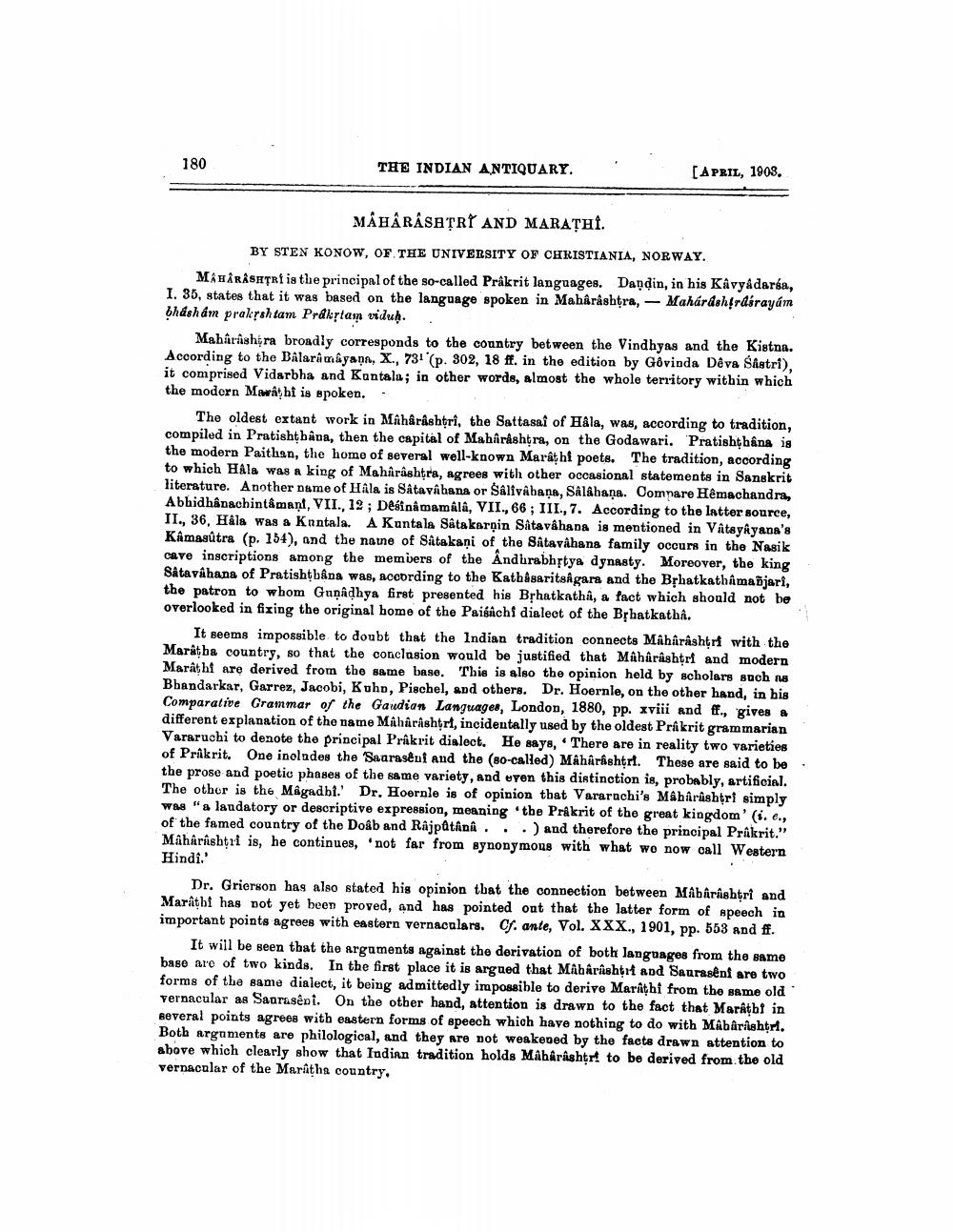________________
180
THE INDIAN ANTIQUARY.
[APRIL, 1903.
MÂLÂ RASAȚRE AND MARATHI. BY STEN KONOW, OF THE UNIVERSITY OF CHRISTIANIA, NORWAY. MAHARASHTRi is the principal of the so-called Prakrit languages. Dandin, in his Kavyadarsa, I. 35, states that it was based on the language spoken in Mahârâshtra, - Mahárdshirdýrayám bháshám prakrshtam Prækplan viduh.
Maharishira broadly corresponds to the country between the Vindhyas and the Kistna. According to the Balaramayaņa, X., 73 (p. 302, 18 ff. in the edition by Govinda Dêva Sastri), it comprised Vidarbha and Kantala; in other words, almost the whole territory within which the modern Marashi is spoken..
The oldest extant work in Maharashtri, the Sattasai of Hala, was, according to tradition, compiled in Pratishthana, then the capital of Maharashtra, on the Godawari. Pratishthâna is the modern Paithen, the home of several well-known Marathi poets. The tradition, according to which Hala was a king of Maharashtra, agrees with other occasional statements in Sanskrit literature. Another name of Hala is Satavahana or Salivabana, Sâlâhana. Compare Hêmachandra, Abhidhânachintamant, VII., 12 ; Dešinamamala, VII., 66 ; III., 7. According to the latter source, II., 36, Háls was a Kantala. A Kuntala Sâtakarņin Satavahana is mentioned in Vâtsyâyana's Kámasútra (p. 154), and the naine of Satakani of the Satavahana family occurs in the Nasik cave inscriptions among the members of the Andhrabhstya dynasty. Moreover, the king Såta våhana of Pratishtbåna was, according to the Kathåsaritsigara and the Brhatkathamañjari, the patron to whom Gañadhya first presented his Brhatkatha, a fact which should not be overlooked in fizing the original home of the Paisachi dialect of the Brhatkathả.
It seems impossible to doubt that the Indian tradition connects Maharashtrt with the Maratha country, so that the conclusion would be justified that Maharashtri and modern Marathi are derived from the same base. This is also the opinion held by scholars such as Bhandarkar, Garrez, Jacobi, Kuhn, Pischel, and others. Dr. Hoernle, on the other hand, in his Comparative Grammar of the Gaudian Languages, London, 1880, pp. xviii and ff., gives a different explanation of the name Maharashtrt, incidentally used by the oldest Prakrit grammarian Vararuchi to denote the principal Prakrit dialect. He says, There are in reality two varieties of Prakrit. One inoludes the Saarasênt and the (80-called) Maharashtrt. These are said to be the prose and poetic phases of the same variety, and even this distinction is, probably, artificial. The other is the Magndbi.' Dr. Hoernle is of opinion that Vararachi's Maharashtri simply WA "& laudatory or descriptive expression, meaning the Prakrit of the great kingdom' i. e., of the famed country of the Doâb and Rajpatana ...) and therefore the principal Prakrit." Maharashtri is, he continues, not far from synonymous with what wo now call Western Hindi.'
Dr. Grierson has also stated his opinion that the connection between Mabarishtri and Marathi has not yet been proved, and has pointed out that the latter form of speech in important points agrees with eastern vernaculars. Cf. ante, Vol. XXX., 1901, pp. 553 and ff.
It will be seen that the arguments against the derivation of both languages from the same base are of two kinds. In the first place it is argued that Maharashtrt and Saurasênt are two forms of the same dialect, it being admittedly impossible to derive Marathi from the same old vernacular as Sauraseni. On the other hand, attention is drawn to the fact that Marktbt in several points agrees with eastern forms of speech which have nothing to do with Maharashtri. Both arguments are philological, and they are not weakened by the facts drawn attention to above which clearly show that Indian tradition holds Maharashtrt to be derived from the old vernacular of the Maratha country,




